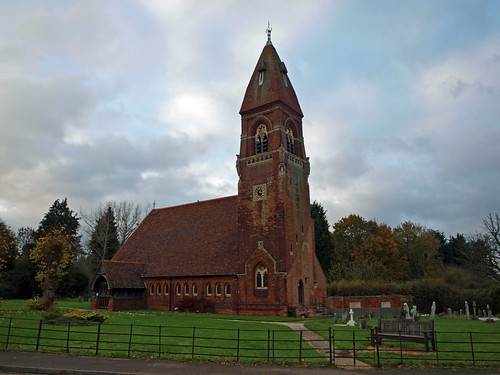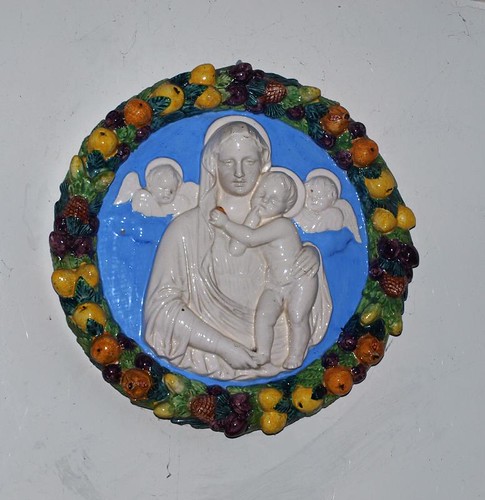Another oddity here. I know in every bone of my body that I shouldn't like St John the Evangelist but like some guilty secret I have to admit that I find it rather appealing. All this visiting is plainly weakening my general dislike of Victoriana - a bit of a worry.
St John the Evangelist was locked with no sign of a keyholder so I can't provide an opinion, but I am fairly sure it would be negative.
UPDATE: I regular pass this way when visiting and equally often stop on the off chance it will be open and on my way back from the successful Great Waltham trip I decided to try my luck and found it open. As I suspected there's little to no interest inside but there is a rather nice Della Robbia style Madonna and Child plaque - the quality does not seem good enough for it to be the real thing - with Christ holding an apple.
ST JOHN THE EVANGELIST. 1871 by Chancellor; chancel added 1893 (GR). Tower with spire with an oddly broken outline, at the E end of the S aisle. It is adorned by large figures of the Evangelists at the angles. S aisle covered by the same big roof as the nave. Low one-light s aisle windows. Polygonal apse. The S porch of an unusual timber construction, not following medieval precedent. The main uprights lean towards the centre and are in fact straight braces. The brickwork inside the church is exposed.
UPDATE: I regular pass this way when visiting and equally often stop on the off chance it will be open and on my way back from the successful Great Waltham trip I decided to try my luck and found it open. As I suspected there's little to no interest inside but there is a rather nice Della Robbia style Madonna and Child plaque - the quality does not seem good enough for it to be the real thing - with Christ holding an apple.
ST JOHN THE EVANGELIST. 1871 by Chancellor; chancel added 1893 (GR). Tower with spire with an oddly broken outline, at the E end of the S aisle. It is adorned by large figures of the Evangelists at the angles. S aisle covered by the same big roof as the nave. Low one-light s aisle windows. Polygonal apse. The S porch of an unusual timber construction, not following medieval precedent. The main uprights lean towards the centre and are in fact straight braces. The brickwork inside the church is exposed.
Its entry on achurchnearyou.com reads: This lovely church (built in 1870 on an osier bed) was designed by Frederic Chancellor, with a super-confident catslide roof over the south aisle. The simple interior has wonderfully precise brickwork, a lovely arcade to the south aisle and windows of cathedral glass. It has a fine acoustic for the spoken word. The unstable ground led to the demolition of the east end (the foundations remain and, in my opinion, are interesting in themselves), and for many years the tower was believed unsafe for bell-ringing, but now our fine peal of 6 bells (the lightest of its type in Essex) rings out joyfully again. Statues of Matthew, Mark, Luke and John guard the corners of the tower. Inside we treasure the memorial to Rev’d Arthur Shearly Cripps, vicar here twice, who is revered as virtually a saint in Zimbabwe where he served as missionary. We also have Rolls of Duty & Honour listing villagers who volunteered to serve in WWI.
I think its a bit cheeky of Mee to review Ford End by actually reviewing North End!
Flickr.


No comments:
Post a Comment